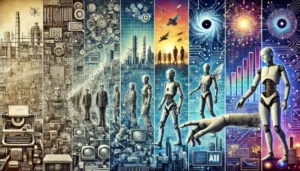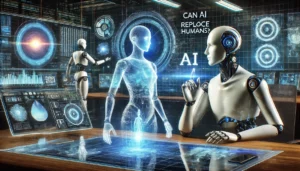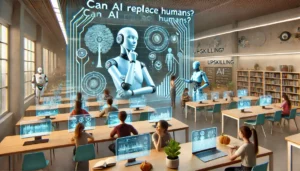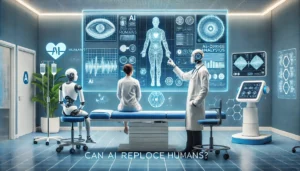Can AI Replace Humans? Coexisting with AI: A New Era of Collaboration

Artificial Intelligence (AI) is changing how we live and work. Instead of replacing humans, AI is becoming a partner, helping us in many ways. This article explores how AI and humans can work together, making our lives better and our work more efficient.
Key Takeaways
- AI has evolved from a rival to a collaborator, enhancing human abilities rather than replacing them.
- The fear that AI will replace humans often comes from science fiction, not reality.
- Augmented Intelligence combines human and AI strengths to solve complex problems more effectively.
- AI is transforming job roles by automating repetitive tasks and creating new opportunities.
- Ethical considerations are crucial to ensure AI benefits everyone and remains fair and accountable.
Can AI Replace Humans? The Evolution of AI and Human Collaboration
Historical Context of AI Development
Artificial Intelligence (AI) has come a long way since its inception. Initially, the idea of machines thinking like humans was purely science fiction. Over the decades, we’ve seen AI evolve from simple rule-based systems to complex algorithms capable of learning and adapting. This journey has been marked by significant milestones that have shaped our understanding and expectations of AI.
Milestones in AI-Human Interaction (Can AI Replace Humans?)
Throughout history, there have been key moments that have defined the relationship between AI and humans. From the creation of the first neural networks to the development of advanced machine learning models, each milestone has brought us closer to a more integrated coexistence. These advancements have not only improved the capabilities of AI but have also enhanced our ability to collaborate with these systems.
The Shift from Rivalry to Collaboration
In the early days, there was a prevalent fear that AI would replace humans in various fields. However, as technology has progressed, we’ve seen a shift in this narrative. Today, the focus is on how AI can augment human abilities rather than replace them. This shift from rivalry to collaboration has opened up new possibilities for innovation and efficiency. Businesses must marry the possibilities offered by AI with true human engagement to fully realise the potential of this technology.
Understanding the Fear: Can AI Replace Humans?
Origins of the Replacement Fear
The fear that AI might replace humans has deep roots. It often stems from science fiction stories and doomsday scenarios. These tales paint a future where intelligent machines surpass human abilities, leading to mass unemployment and existential crises. While these dystopian visions capture our imagination, they oversimplify the complex relationship between AI and human intelligence.
Science Fiction vs. Reality (Can AI Replace Humans?)
In reality, the relationship between AI and humans is more nuanced. AI is not here to replace us but to work alongside us. For instance, AI can process vast amounts of data quickly, identifying patterns and making predictions. Humans, on the other hand, excel at intuition, empathy, and context-aware decision-making. Together, AI and humans can form a symbiotic relationship where each complements the other’s strengths.
Public Perception and Media Influence
Public perception of AI is heavily influenced by media portrayals. Movies and books often depict AI as a threat, which can lead to unnecessary fear. However, it’s important to focus on the real-world applications of AI, which are designed to augment human capabilities rather than replace them. By understanding the true potential of AI, we can better appreciate how it can enhance our lives rather than diminish them.
Technology progression and advancement has always been met with fear and anxiety, giving way to tremendous gains for humankind as we learn to enhance the best of the changes and adapt and alter the worst.
In summary, while the fear of AI replacing humans is understandable, it is largely unfounded. By focusing on collaboration rather than competition, we can harness the power of AI to create a better future for all.
Can AI Replace Humans? Augmented Intelligence: Enhancing Human Capabilities
What is Augmented Intelligence?
Augmented Intelligence (AI) is all about machines and humans working together. Instead of replacing us, AI helps us do things better. Think of it as a team where each member has unique strengths. Machines can process data super fast, while we bring intuition and empathy to the table. This partnership makes us stronger and more efficient.
Examples of Augmented Intelligence in Action (Can AI Replace Humans?)
We see Augmented Intelligence in many areas of our lives. Here are a few examples:
- Healthcare: AI helps doctors diagnose diseases faster and more accurately.
- Education: AI tools personalise learning experiences for students.
- Business: AI analyses data to help companies make better decisions.
In each case, AI doesn’t replace humans. Instead, it supports us, making our work easier and more effective.
Benefits of Human-AI Collaboration
Working with AI has many benefits. Here are some key points:
- Enhanced Decision-Making: AI processes large amounts of data quickly, giving us insights we might miss. We then use our judgement to make the best decisions.
- Increased Productivity: AI handles repetitive tasks, freeing us up for more creative and strategic work.
- Better Outcomes: By combining our strengths with AI, we achieve better results in various fields.
The shift towards Augmented Intelligence marks a new era of collaboration. It’s not about machines taking over but about working together to achieve more.
As we embrace this change, we open up new possibilities for innovation and progress. The future is bright when we work hand in hand with AI.
Can AI Replace Humans? AI in the Workplace: Transforming Job Roles
Automation of Repetitive Tasks
AI is revolutionising the workplace by automating repetitive tasks. This allows us to focus on more strategic and creative aspects of our jobs. For instance, AI-powered chatbots provide instant and personalised assistance, freeing up human workers for more complex tasks. This shift not only boosts productivity but also enhances job satisfaction.
AI-Assisted Decision Making (Can AI Replace Humans?)
AI is also enhancing decision-making processes. By analysing vast amounts of data, AI can offer insights that help us make better decisions. In HR, for example, AI can automate the screening of job applications, allowing HR professionals to focus on more strategic goals. This is similar to how Google AdWords PPC campaigns are optimised using AI to target the right audience.
New Job Opportunities Created by AI
While AI automates certain tasks, it also creates new job opportunities. Roles such as AI trainers, data analysts, and AI ethicists are emerging. These roles require a blend of technical and soft skills, ensuring that the human touch remains essential in the workplace.
The synergy between AI and human expertise creates a dynamic environment where innovation flourishes, driving industries towards greater competitiveness and sustainability.
Can AI Replace Humans? Education and Upskilling for an AI Future
The Importance of Lifelong Learning
In an era where AI is rapidly evolving, lifelong learning becomes essential. We must continuously update our skills to stay relevant. This isn’t just about keeping up with technology; it’s about thriving in a world where AI and humans work together. Lifelong learning ensures that we can adapt to new roles and responsibilities as they emerge.
Skills Needed in an AI-Driven World (Can AI Replace Humans?)
To succeed in an AI-driven world, we need a mix of technical and soft skills. Technical skills like coding, data analysis, and machine learning are crucial. However, soft skills such as critical thinking, creativity, and emotional intelligence are equally important. These skills help us collaborate effectively with AI and leverage its capabilities to the fullest.
Adapting Education Systems
Our education systems must evolve to meet the demands of the AI era. This means integrating AI into the curriculum and providing students with hands-on experience with AI tools. Schools and universities should focus on teaching both the technical and soft skills required for the future. Additionally, we need to create flexible learning pathways that allow individuals to upskill and reskill throughout their careers.
The future of work is not about AI replacing humans but about humans and AI working together. By embracing lifelong learning and adapting our education systems, we can ensure that everyone benefits from the advancements in AI.
Can AI Replace Humans? Ethical Considerations in AI Integration
Responsibility and Accountability
As AI becomes more integrated into our lives, we must address the ethical challenges it brings. One major concern is responsibility and accountability. Who is to blame when an AI system makes a mistake? We need clear guidelines to ensure that both developers and users are held accountable. This is crucial for building trust in AI technologies.
Bias and Fairness in AI (Can AI Replace Humans?)
AI systems can sometimes reflect the biases present in their training data. This can lead to unfair outcomes, especially in areas like hiring and law enforcement. To tackle this, we must focus on creating fair and transparent AI systems. Regular audits and updates can help in identifying and mitigating biases.
Ensuring Ethical AI Deployment
Deploying AI ethically involves more than just following the rules. It requires a commitment to doing what is right. This includes respecting user privacy, ensuring data security, and being transparent about how AI systems make decisions. By prioritising these values, we can create AI technologies that benefit everyone.
As we navigate the complexities of AI ethics, it becomes clear that a responsible and inclusive approach is essential to harness the potential of AI while mitigating its risks.
In conclusion, ethical considerations are not just an afterthought but a fundamental part of AI development and deployment. By addressing these issues head-on, we can ensure that AI serves humanity in a fair and equitable manner.
Can AI Replace Humans? AI and Human Synergy in Healthcare
AI in Medical Diagnostics
In healthcare, AI has become a game-changer, especially in medical diagnostics. By analysing vast amounts of medical data, AI can identify patterns and anomalies that might be missed by human eyes. This leads to quicker and more accurate diagnoses, which is crucial for early disease detection and treatment. AI’s ability to process and interpret complex datasets allows doctors to make more informed decisions, ultimately improving patient outcomes.
Enhancing Patient Care with AI (Can AI Replace Humans?)
AI is not just about diagnostics; it also plays a significant role in enhancing patient care. From personalised treatment plans to virtual health assistants, AI helps us provide more tailored and efficient care. For instance, AI can monitor patient vitals in real-time, alerting healthcare providers to any sudden changes. This proactive approach ensures that patients receive timely interventions, reducing the risk of complications.
Collaborative Research and Development
The collaboration between AI and human intelligence extends to research and development. AI algorithms can sift through vast amounts of research data, identifying potential new treatments and therapies. This accelerates the pace of medical research, bringing new solutions to the market faster. Moreover, AI can help us design more effective clinical trials by identifying suitable candidates and predicting outcomes.
The integration of AI in healthcare is not about replacing human doctors but augmenting their capabilities. Together, we can achieve better patient outcomes and push the boundaries of medical science.
In summary, the synergy between AI and human intelligence in healthcare is transforming the way we diagnose, treat, and research medical conditions. By working together, we can create a more efficient and effective healthcare system.
Can AI Replace Humans? The Role of AI in Creative Industries
AI in Art and Music
Artificial Intelligence is revolutionising the creative industries, particularly in art and music. We see AI-generated paintings and compositions that challenge our understanding of creativity. These innovations are not just novelties; they are reshaping how we perceive artistic expression. AI tools can now create music and art that evoke emotions similar to human-made works. This opens up new possibilities for artists and musicians to collaborate with AI, pushing the boundaries of what is possible.
Augmenting Creativity with AI Tools (Can AI Replace Humans?)
AI tools are becoming indispensable in the creative process. From generating ideas to refining final products, these tools offer unprecedented support. For instance, AI can analyse vast amounts of data to provide insights that would take humans much longer to uncover. This is particularly useful for a PPC ecommerce agency looking to optimise their advertising strategies. By leveraging AI, creative professionals can focus more on the conceptual aspects of their work, leaving the repetitive tasks to machines.
Human-AI Collaboration in Content Creation
The collaboration between humans and AI in content creation is a game-changer. We are witnessing a shift where AI assists in generating content, but the human touch remains crucial. This synergy is evident in various fields, from writing to video production. For example, an ecommerce PPC campaign can benefit from AI-generated content that is then fine-tuned by human experts. This ensures that the final product is both efficient and engaging, balancing the strengths of both parties.
In the dynamic and hybrid context of today’s corporate world, collaboration is a crucial element in the success of businesses. The emergence of artificial intelligence (AI) will facilitate exchanges and rapid decision-making, which drive success and open up unprecedented perspectives.
In summary, the role of AI in creative industries is transformative. It not only enhances human capabilities but also opens up new avenues for artistic and creative expression. As we continue to explore this synergy, the possibilities are endless.
Can AI Replace Humans? Building a Future of Human-AI Coexistence
Embracing Change and Innovation
As we move forward, it’s crucial to embrace change and innovation. We must be open to new ideas and technologies that can improve our lives. Innovation drives progress, and by working together, humans and AI can achieve great things.
Balancing Efficiency and Human Touch (Can AI Replace Humans?)
While AI can handle many tasks efficiently, it’s important to maintain the human touch. We need to find a balance between using AI for efficiency and keeping the personal connections that make us human. This balance will help us create a more harmonious future.
Creating Policies for a Collaborative Future
To ensure a successful future, we need to create policies that support collaboration between humans and AI. These policies should focus on fairness, transparency, and accountability. By doing so, we can build a future where AI is a tool for positive transformation without compromising our values.
As we look ahead, we must focus on creating a future where humans and AI work together for the betterment of society. This means embracing change, balancing efficiency with human touch, and creating policies that support collaboration.
Let’s work together to build a future where humans and AI coexist harmoniously, benefiting from the best of both worlds.
Can AI Replace Humans? The Economic Impact of AI on Global Markets
AI-Driven Economic Growth
Artificial intelligence (AI) is reshaping industries and driving economic growth. By automating repetitive tasks, AI allows us to focus on more complex and creative work. This shift can lead to increased productivity and efficiency across various sectors. AI’s ability to analyse vast amounts of data quickly and accurately helps businesses make better decisions, ultimately boosting economic performance.
Challenges and Opportunities (Can AI Replace Humans?)
While AI offers numerous benefits, it also presents challenges. One major concern is job displacement. As machines take over tasks traditionally performed by humans, some jobs may become obsolete. However, AI also creates new opportunities. For instance, there is a growing demand for AI specialists, data scientists, and cybersecurity experts. To thrive in this new landscape, we must adapt and acquire new skills.
Preparing for Economic Shifts
To prepare for the economic shifts brought about by AI, we need to invest in education and training. Lifelong learning is essential to keep up with the rapid pace of technological advancements. Governments and businesses should collaborate to create policies that support workforce development and ensure that everyone has access to the resources they need to succeed in an AI-driven world.
Embracing AI’s potential while addressing its challenges is crucial for building a prosperous future. By fostering a culture of innovation and continuous learning, we can harness the power of AI to drive economic growth and improve our quality of life.
AI and Human Interaction: A New Social Paradigm
AI in Everyday Life
We are witnessing AI becoming a part of our daily routines. From virtual assistants like Siri and Alexa to recommendation systems on Netflix and Amazon, AI is everywhere. These technologies help us manage our time, make decisions, and even entertain us. AI’s integration into our lives is seamless, making tasks easier and more efficient.
Social Implications of AI Integration
The rise of AI brings significant social changes. It affects how we communicate, work, and even form relationships. While some fear that AI might replace human jobs, it also creates new opportunities. We must adapt to these changes and find ways to coexist with AI. This shift requires us to rethink our roles and how we interact with technology.
Fostering Human Connections in an AI World
Despite the rise of AI, human connections remain vital. AI can enhance these connections by taking over mundane tasks, allowing us to focus on more meaningful interactions. For instance, AI can help in healthcare by managing patient records, giving doctors more time to spend with patients. In education, AI can handle administrative tasks, letting teachers focus on teaching and mentoring students.
As we embrace AI, we must ensure it serves to enhance, not replace, our human connections. This balance is crucial for a harmonious future.
In conclusion, AI is reshaping our social landscape. It offers numerous benefits, but we must navigate its integration thoughtfully. By doing so, we can create a society that benefits from the best of both worlds.
The way we interact with AI is changing how we live and work. It’s creating new ways for us to connect and understand each other. If you’re curious about how AI can help your business grow, visit our website. We have lots of resources and expert advice to guide you.
Conclusion
In conclusion, the rise of AI does not signal the end of human roles but rather the beginning of a new era of collaboration. AI can handle repetitive tasks, freeing us to focus on creative and meaningful work. By working together, humans and AI can achieve more than either could alone. This partnership allows us to solve complex problems and innovate in ways we never thought possible. As we move forward, it’s essential to embrace this synergy, ensuring that technology enhances our lives while we continue to value human creativity and judgement. The future is bright for those who see AI as a partner rather than a replacement.
Frequently Asked Questions
What is AI?
AI, or Artificial Intelligence, is a type of technology that allows machines to learn from experience and perform tasks that usually require human intelligence, like recognising speech or making decisions.
Can AI completely replace humans?
No, AI cannot completely replace humans. While it can handle many tasks, humans are still needed for their creativity, emotional intelligence, and complex decision-making skills.
How does AI help in the workplace?
AI helps in the workplace by automating repetitive tasks, assisting in decision-making, and creating new job opportunities that require human-AI collaboration.
What is augmented intelligence?
Augmented intelligence is when AI is used to enhance human abilities rather than replace them. It means working together with AI to achieve better results.
Why are people afraid of AI?
People are often afraid of AI because of science fiction stories and media that show AI taking over the world. In reality, AI is a tool that can help us if used responsibly.
What skills are important in an AI-driven world?
In an AI-driven world, skills like critical thinking, creativity, adaptability, and the ability to work with technology are very important.
How is AI used in healthcare?
AI is used in healthcare to help with medical diagnostics, improve patient care, and support collaborative research and development.
What ethical concerns are there with AI?
Ethical concerns with AI include ensuring fairness, avoiding bias, and making sure that AI systems are used responsibly and accountably.
Author
Search Blog
Free PPC Audit
Subscribe to our Newsletter
The Voices of Our Success: Your Words, Our Pride
Don't just take our word for it. With over 100+ five-star reviews, we let our work-and our satisfied clients-speak for us.
"We have been working with PPC Geeks for around 6 months and have found Mark and the team to be very impressive. Having worked with a few companies in this and similar sectors, I rate PPC Geeks as the strongest I have come across. They have taken time to understand our business, our market and competitors and supported us to devise a strategy to generate business. I value the expertise Mark and his team provide and trust them to make the best recommendations for the long-term."
~ Just Go, Alasdair Anderson




